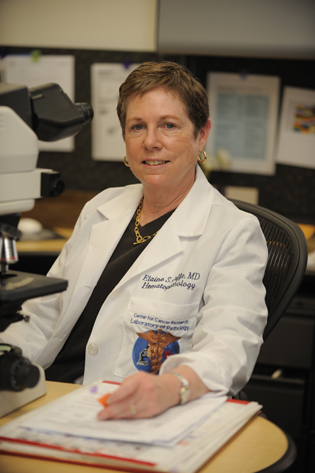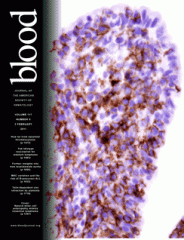B Cells, T Cells, and Natural Killers, Oh My!
Elaine Jaffe Puts Lymphomas in Their Place
Cancers are not created equally. NIH hematopathologist Elaine Jaffe, whose work focuses on cancers of the blood-forming system, knows all too well how subtle variations can have an impact on diagnoses and treatment. Indeed, she has exploited those variations in her search for treatments. In scrutinizing minute differences among malignant lymphomas, Jaffe has conducted pioneering studies related to their classification and has led an international effort for consensus among clinicians and pathologists.
As head of the Hematopathology Section in the National Cancer Institute’s (NCI’s) Laboratory of Pathology, she is continuing to explore the pathophysiology and prognosis of all sorts of lymphomas, especially the interrelationship between Hodgkin lymphoma (a cancer of the lymph nodes) and diffuse large B-cell lymphomas and the genetic or epigenetic mechanisms that cause a B cell to become a Hodgkin cell.

Elaine Jaffe has conducted pioneering studies related to the classification, diagnosis, and treatment of lymphomas.
Jaffe, now a member of the Institute of Medicine (IOM), discovered her passion for pathology as a second-year medical student at Cornell Medical College (New York) before transferring to the University of Pennsylvania Medical School (Philadelphia) and graduating in 1969.
“I saw pathology as laying the groundwork for the understanding of all disease states,” she told the American Society for Hematology News Daily upon the occasion of winning the organization’s prestigious Henry M. Stratton Medal in 2013. “An astute pathologist can discern many facets of the patient history and course from a single slide—[such as] the age, sex, clinical symptoms, sites of disease, and patterns of spread. To me, the power of the visual microscopic image is as great as a gene-expression microarray reporting on the activity of thousands of genes.”
After graduating from medical school, Jaffe completed a one-year internship in pathology at Georgetown University Hospital (Washington, D.C.) before moving to the residency program in the NCI’s Laboratory of Pathology in 1970. She arrived there just as a paradigm shift was occurring in the field of cancer therapy.
“For the first time it was shown that chemotherapy could cure patients with lymphomas and Hodgkin disease,” she said. In fact, two NCI scientists—Paul Carbone and Vincent DeVita—received Lasker Awards in 1972 for their contributions to the concept of combination chemotherapy to successfully treat Hodgkin disease.
At the same time, the understanding of the immune system was exploding. And immunologists around the world were developing techniques to identify the specific types of immune cells, or lymphocytes, that certain lymphomas were derived from. Lymphomas can emerge from one of three types of lymphocytes: T cells, B cells, or natural killer (NK) cells, each of which has numerous subtypes. “Under the microscope, a T cell and a B cell look the same,” Jaffe explained. “But immunologists were discovering surface markers on cells that could allow you to identify [them] in terms of their cell of origin.”
These developments—the discovery that chemotherapy could cure certain cancers and the development of techniques to identify the immune cells that cancer cells were derived from—made hematopathology an exciting field. It’s not surprising, then, that Jaffe decided to remain at the NCI as a fellow in hematopathology and pursue her interests in blood diseases. Along with her mentor, Cos Berard, and National Institute of Allergy and Infectious Disease (NIAID) immunologists Ira Green, Michael Frank, and Ethan Shevach, Jaffe applied those new techniques to lymphoma for the first time.
“If lymphomas were malignancies of lymphocytes, then we should be able to characterize them as to their T-cell or B-cell origin,” she said. They ultimately showed that a type of lymphoma then called nodular lymphoma came from a specific type of lymphocyte called a follicular B cell (N Engl J Med 290:813–819, 1974).
“It was one of the very first studies to show that you could identify the cell of origin of a lymphoma,” Jaffe explained. “This had been done in cell suspension before, but this was the first time the technique had actually been applied to tissue sections [in which] you could not only visualize the marker [on the cells] but [also] visualize the cells in their normal environment.” That paper was so heavily cited by other scientists that it became a “citation classic.”
The ability to precisely classify lymphomas carried large implications for cancer treatment: Certain therapies may be more or less effective against specific types of cancer. But it also created conflicts among different systems of classification. “Back in the 1970s, when these studies were first coming into their heyday, it led to a lot of excitement in the field, but it also led to a lot of confusion because different groups in different parts of the world were coming up with their own independent classification systems,” Jaffe explained. For example, the Kiel classification system was widely used in Europe, while the Rappaport classification system was popular in the United States.
“It was a problem because you had pathologists using different [terminologies] and you had clinicians using different [ones],” she continued. “And when clinical trials were reported, you couldn’t readily compare a clinical trial in Europe with a clinical trial in the U.S. because the diagnoses were not the same.”
These differences in how lymphomas were classified posed problems not only for scientists seeking a common language with which to discuss their research, but also for doctors attempting to provide the best care for their patients. Some classification systems lumped several types of lymphoma together under the same name, whereas others treated them as distinct entities.
“The field was pretty primitive in terms of the technology that was being applied,” Jaffe said. “Most of [the classifications] were based on morphologic observations that were made under the microscope with not a lot of scientific validation, so there were differences in the number of different diseases that were described, how they were diagnosed, and how they might be treated.”
To settle the issue once and for all, Jaffe joined a group of hematopathologists from around the world to establish the International Lymphoma Study Group in 1991. Working face to face, the 19 international participants found it easy to develop consensus, and, in 1994, the group published the Revised European-American Lymphoma (REAL) classification, which quickly became the gold standard for classifying lymphomas (Blood 84:1361–1392, 1994).
“The term ‘REAL’ was tongue-in-cheek,” Jaffe explained. “The acronym was chosen to say, ‘these are the real diseases that we’re recognizing. So it was a sort of play on words.” The REAL classification system paper, which described more than 50 different types of lymphoma, became one of the five most highly cited papers in clinical medicine over the next 10 years. The REAL system “was more clinically useful,” because it provided specific criteria for diagnosing lymphoma, Jaffe explained. “It was better at identifying various disease entities and identifying correlations with prognosis.”
Jaffe has also contributed to her field through her work outside the lab: She has served on the editorial boards of 18 different journals; was president of the Society for Hematopathology as well as of the United States and Canadian Academy of Pathology; and has won numerous awards in recognition of her work. In 2008, she was elected to the IOM. She takes special pride, however, in her work as director of the NCI’s two residency programs.
“I enjoy teaching at the microscope and helping people understand pathology and, in particular, hematopathology,” she said. “I have a very close relationship with most of my former fellows [and] residents. They keep in touch with me on a regular basis and let me know about their accomplishments and achievements. [It’s] very rewarding to see them succeed on their own and make their mark in the field.”
One former clinical fellow who has made his mark is Joo Song, who worked with Jaffe from 2009 to 2011. He is now an assistant clinical professor in the Department of Pathology at the City of Hope (Duarte, California), an NCI-designated comprehensive cancer center. Song credits Jaffe with helping him develop a love of research. “She was paramount in teaching me to conduct meaningful research and [to] also have a critical eye when reviewing the literature.”
Jaffe attributes her success to the support of her husband and two sons and to a strong dedication to her work. She offers this advice to others: “Finish what you start.” She cautioned that, “if you’re new and you’re very excited about everything that’s happening, there’s always a risk of becoming diffuse and starting a project and not finishing it.”
There have been times, however, when she hasn’t followed her own advice. “It’s always easier to tackle the easy problems,” she admitted. “Some of the difficult ones get put aside, and it’s sometimes hard to get back to them. I have a mental file of things that didn’t get finished, unfortunately.”
Indeed, Jaffe’s work is far from done. Nowadays, her research takes advantage of new techniques for analyzing the DNA of tumor cells. “I think the field of oncology is really undergoing revolutionary change with the ability to sequence essentially all human tumors,” she said. “We’re beginning to understand the genomic complexity of human tumors, and I think this will lead to a better understanding of the pathways of oncogenesis, but also probably influence the classification of disease and hopefully the treatment of disease as well.”

Along the way Jaffe has identified new disease entities. She is particularly proud of a 2011 study describing NK-cell enteropathy, which was featured on the cover of the journal Blood (Blood 117:1447–1452, 2011). It is a benign disorder that simulates lymphoma under the microscope. “With NK-cell enteropathy, probably a lot of those cases were called T-cell lymphoma, and patients were treated aggressively and received therapy that they really didn’t need or didn’t benefit from,” Jaffe said. “So identifying [NK-cell enteropathy] as a disease and alerting people to its existence so future patients are not misdiagnosed is a significant achievement.”
Although English physician Thomas Hodgkin first described lymphoma in 1832, it took more than 180 years before the REAL classification produced a reliable and broadly supported system for distinguishing among its many forms. But as Jaffe’s recent research shows, there remain categories of the disease yet to be rigorously defined.
This page was last updated on Tuesday, April 26, 2022
